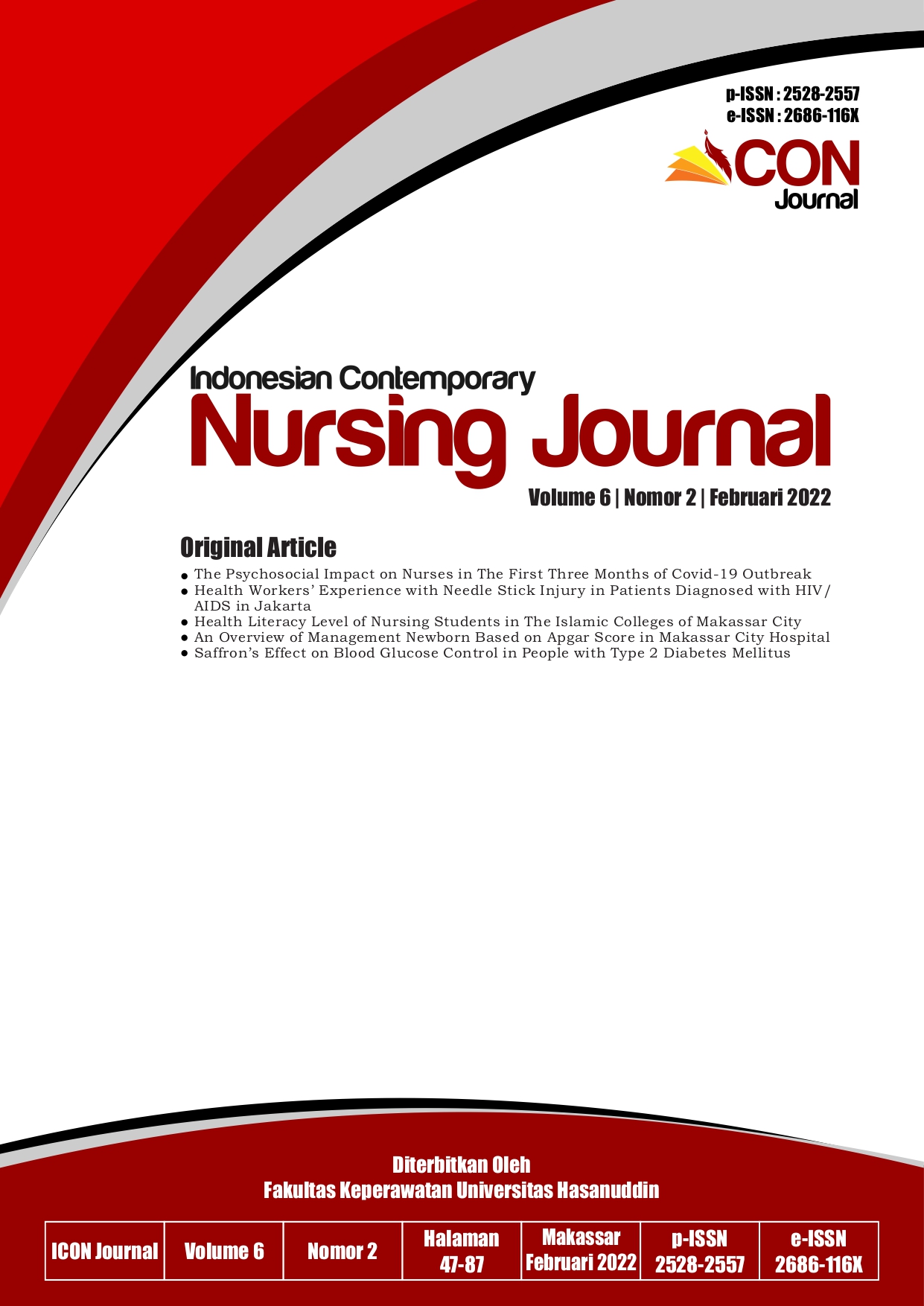An Overview of Management Newborn Based on Apgar Score in Makassar City Hospital
Keywords:
Newborn, Apgar Score, AsphyxiaAbstract
Introduction: The Apgar Score assessment is carried out after the baby is born to assess the baby’s condition and determine the initial treatment measures to be taken. The aim of this research is to get a description of the treatment in newborns based on the Apgar score at the Makassar City Hospital. The sample was obtained as many as 256 babies born at the Makassar City Hospital. Method: This study used the quantitative design with descriptive methods. The instrument used are observation sheet based on data from medical records. Result: In this study, the results showed that babies born with an Apgar score of 7-10 at 1st minute did not require oxygen assistance (83,2%), and suctioning of the mucus was performed which generally used a bulb syringe (84%), all newborns with an Apgar score of 7-10 no resuscitation was performed. Conclusion: Our results suggest that newborns with an Apgar score of 0-3 undergo routine treatment such as loan suction using a suction cannula, provide positive pressure ventilation using a t-piece resuscitator and perform resuscitation measures. However it is important to monitor oxygen saturation before administering oxygen therapy. It is expected that the nurse/midwife will give treatment based on SOP and conform to the Apgar Score. For future researchers to examine the long-term effects of oxygen use in infants.Downloads
Download data is not yet available.
Dimensions
Published
2022-06-03
How to Cite
Andis, A. S., Seniwati, T., & Fadilah, N. (2022). An Overview of Management Newborn Based on Apgar Score in Makassar City Hospital. Indonesian Contemporary Nursing Journal (ICON Journal), 6(2), 70-79. https://doi.org/10.20956/icon.v6i2.12055
Issue
Section
ARTICLES
Copyright & Licensing
Authors who publish with this journal agree to the following terms:
Authors retain copyright and grant the journal right of first publication with the work simultaneously licensed under a Creative Commons Attribution License that allows others to share the work with an acknowledgement of the work's authorship and initial publication in this journal.
Authors are able to enter into separate, additional contractual arrangements for the non-exclusive distribution of the journal's published version of the work (e.g., post it to an institutional repository or publish it in a book), with an acknowledgement of its initial publication in this journal.
Authors are permitted and encouraged to post their work online (e.g., in institutional repositories or on their website) prior to and during the submission process, as it can lead to productive exchanges, as well as earlier and greater citation of published work (See The Effect of Open Access).
Authors retain copyright and grant the journal right of first publication with the work simultaneously licensed under a Creative Commons Attribution License that allows others to share the work with an acknowledgement of the work's authorship and initial publication in this journal.
Authors are able to enter into separate, additional contractual arrangements for the non-exclusive distribution of the journal's published version of the work (e.g., post it to an institutional repository or publish it in a book), with an acknowledgement of its initial publication in this journal.
Authors are permitted and encouraged to post their work online (e.g., in institutional repositories or on their website) prior to and during the submission process, as it can lead to productive exchanges, as well as earlier and greater citation of published work (See The Effect of Open Access).
Most read articles by the same author(s)
- Sumitarianti Bahris, Moh Syafar Sangkala, Tuti Seniwati, Overview of Post Traumatic Stress Disorder (PTSD) Symptoms of Post-Road Traffic Accident Patients , Indonesian Contemporary Nursing Journal (ICON Journal): Volume 5 No. 1 Agustus 2020
- Dewita Amanda Bandung, Tuti Seniwati, Nurfadhilah Nurfadhilah, Mother’s Perception of Social Skills of Children With Autism in The Special Needs Therapy Center in Makassar , Indonesian Contemporary Nursing Journal (ICON Journal): Volume 1 No. 2 Februari 2017
- Nuurhidayat Jafar, Nur Fadilah, Silvia Malasari, Moh Syafar Sangkala, Andina Setyawati, Andi Wahyuni, Mosquito Nests Eradication through Monitoring the Mosquito Larva (Jumantik) by School Children in Preventing the Dengue Hemorrhagic Fever , Indonesian Contemporary Nursing Journal (ICON Journal): Volume 3 No. 2 Februari 2019
- Sri Rahayu, Elly Lilianty Sjattar, Tuti Seniwati, Factors Affecting Secondary Traumatic Stress Disorder among Search and Rescue Team in Makassar , Indonesian Contemporary Nursing Journal (ICON Journal): Volume 5 No. 2 Februari 2021

